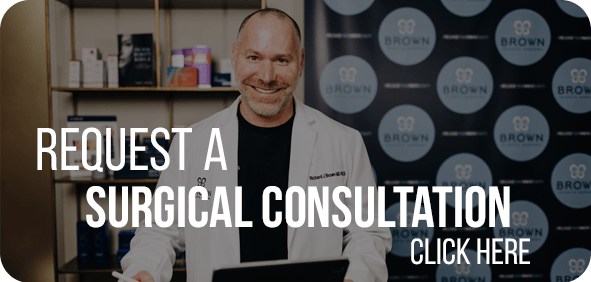body lift over view | procedure
A body lift, or belt lipectomy, is most frequently performed after major weight loss, and accomplishes two goals:
- Removing extra skin and fat in the abdomen, hips and lower back
- Lifting sagging tissue in the outer thighs and buttocks
A body lift combines a tummy tuck (abdominoplasty), and a buttock lift to treat both the front and back of the body. The surgery can also be combined with liposuction to change the contour of the abdomen, hips, and waist.
SURGERY AND THE INCISIONS
The combined operation takes a minimum of 4 hours, or longer if combined with liposuction. The morning of surgery, Dr. Brown will mark the incisions on your abdomen and back. The front body incisions are the same as the tummy tuck incisions. The incision goes around the entire circumference of the body, and in many cases, the incision can be hidden in the panty-line. You can expect to have surgical drains in the front and the back area. These usually can be removed after one week, but sometimes drains may stay in longer depending on how much fluid your body produces.
BEFORE BODY LIFT SURGERY
Preparing for surgery – Tell Dr. Brown about any medical problems you have, and any problems you may have had with surgery in the past. Most importantly, tell your doctor if you have had any hernias or any abdominal surgery in the past. You will be told which medications to stop and which to take before surgery.
The night before surgery you should shower and wash your pubic area with antibacterial soap. Since the incision will end up very close to the pubic hair, you may want to shave the area several days before surgery. If you smoke, you will be asked to quit for a minimum of 4 weeks prior to surgery as well as 4 weeks after surgery. If you get sick or have any health issues in the days before surgery, please notify the office at once in case we have to postpone your operation.
AFTER BODY LIFT SURGERY
Can I go home the day of surgery? – Most patients undergoing a body lift choose to spend one or two nights in the hospital. If the surgery is done in two separate stages, you may be able to go home the same day. Some patients may prefer to spend an extra night or two in the hospital if they have young children, or live alone and do not have any help at home.
What kind of swelling and bruising can I expect? – You will have drains beneath the skin of the abdomen and back region. These drains will be removed 1-2 weeks after surgery. Swelling and bruising are normal signs of the healing process. They occur after any surgery to varying degrees. Swelling peaks at about 48 hours, and then rapidly decreases. By the end of the first few weeks, 50 percent of the swelling is gone. By 6-8 weeks, a majority of the swelling has diminished. By six months, almost all the swelling is gone. Any remaining swelling is almost not perceptible.
What restrictions are there? – You can shower two days after surgery, but you should not take a bath, use a hot-tub, or go swimming for at least two weeks. The first day after surgery is usually spent lying in bed or sitting in a chair. Most patients then begin walking around the house. By the end of the first week, you will probably be ready to leave the house for short trips and light walks. More vigorous walking and mild stretching exercises can be resumed about two weeks after surgery. Strenuous activities should not be done until 6 weeks after surgery. Also, you shouldn’t do any heavy lifting (over 10 pounds) during these 6 weeks.
When can I travel? – Traveling after surgery (air travel, long distance car trips, train rides, etc) should not be done before you have had your first postoperative visit. Typically, this occurs 5-7 days after surgery for suture removal. Patients who are at high risk for developing a blood clot should not travel until instructed by their surgeon. Short car trips under 60 minutes can be done before the first visit. A good rule of thumb is when you are off the stronger pain medication and can get up without assistance you are ready to go for a short drive. You should not drive the car yourself until Dr. Brown gives you clearance for this.
What if I have a problem? – When should I call the office? We always welcome calls from patients. If you have any concerns at any time, please feel free to contact our office. If it is an emergency, the answering service is available 24 hours a day, including weekends and holidays.

PATIENT TESTIMONIALS
"Hi, my name is Diana. I am a patient of Dr. Richard J. Brown. I started my breast reconstruction on March 23, 2012 after having a double mastectomy in May of 2012. Dr. Brown has done an amazing job, my progress is great and my breasts are beautiful once again. Dr. Brown is very compassionate and professional. Thank you Dr. Brown for giving me back what cancer took away from me."*. *Individual results may vary* "My experience with Dr. Brown and his staff has been nothing less than exceptional! It's been a long road. I just completed breast reconstruction/augmentation and removal of excess skin/fat from my upper arms following a 100+ pound weight loss. Very pleased with the early results! Not just highly recommended, but the highest recommendation ever!!!"* *Individual results may vary*- Diana R.
-Lisa W



